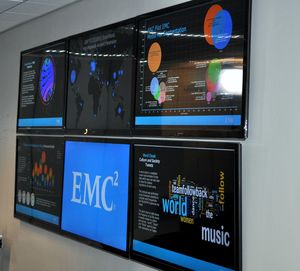At EMC we approach Big Data from every angle—how to store, manage, query, analyze, and visualize it, not to mention secure it. We also use Big Data in our own business, among other things to drive marketing programs. That gave us an idea: If we’re analyzing and directing our business with Big Data, and at the same time working with customers on Big Data solutions for their own businesses , why don’t we show our customers what we’re up to?

We formally opened the lab last February, after about a year of development and have seen roughly 40 customers in the lab to date. Some are Big Data veterans, others are total novices. All hope, with varying levels of specificity and sophistication, to achieve a sustainable competitive advantage through the use of Big Data.And so the Marketing Science Lab was born, a sort of Big Data analytics think tank that supports EMC marketing initiatives but also consults with customers on their needs, demonstrates what Big Data can do for customers who aren’t well-versed in the concept, and showcases EMC technology at our Santa Clara, California Executive Briefing Center.
What I’ve learned from our customers so far is that there are many diverse applications of Big Data across industries, but there are a lot of common themes whether the client is an auto manufacturer, utility, or entertainment company—they need to analyze the data that streams in from installed products, understand the voice of the customer in the social media space, and are looking for new ways to visualize data for better decision-making.
Big Data has three dimensions—volume (or the size of the datasets, which can range from terabytes to petabytes), velocity (or the speed of data transfer which can range from monthly to streaming in real-time), and variety (different types of structures can increase processing complexity). We built the Lab to mine value from each of these characteristics, and talk to customers in those terms as we help them figure out how Big Data fits their businesses and their infrastructures.
Essentially, the customers who come to visit us in the Lab have three subjects on their minds:
- How does one develop a data-driven culture? Here we might talk about EMC’s Data Science curriculum that is designed to train existing analytics professionals in the latest Big Data tools and techniques. In addition to training, we spend a lot of time exploring dashboards and data visualization techniques that allow marketers to see meaningful patterns in the data for decision-making. We’ve also developed an in-house Addictive Analytics program for marketers and non-analytics professionals to teach employees how to leverage analytics in their day-to-day work.

The Marketing Campaign Wheel used to frame analytics in EMC’s Addictive Analytics course - How can companies improve data quality? Everyone has legacy data issues—unstandardized data from many source systems, in addition to the avalanche of new, unstructured Big Data (from sources such as social media or appliances.) Here we may discuss how we created a collaborative analytics environment shared with IT, Manufacturing, and Sales to provide a single source of all data and analysis for a unified Go-To-Market strategy. Or we might talk about the formula underlying a successful data strategy, and our data quality initiatives focused on leveraging business processes and technology to combine data into a reliable 360 degree view of customer demographics, purchasing patterns, media usage, and other dimensions over time.
- How can customers monetize their data, and achieve competitive advantage, in a practical way through the use of advanced analytical techniques (such as text-mining or machine learning)? There are very tactical ways to implement analytics through CRM systems to improve targeting precision (such as next-likely-purchase and lead scoring models), and on the other end of the spectrum, Big Data analytics can inform data-driven strategic marketing decision-making (such as getting a view into the customer buying process within a segment or organization or mining social data to understand the impact of branding).
Now that we have launched the Lab and have a number of projects under our belts, we are starting to work more closely with EMC marketing teams, as well as partners, to implement and scale our work. We’re focused on tools like lead propensity modeling for targeting precision, building customer personas and quantifying the customer buying process to inject more relevance into communication with our customers. We are also building customer lookalike models for new business acquisition—while simultaneously working on data quality to provide what we call “Trusted Analytics.”
We are a very small, very new team, but by collaborating closely with IT, marketers, and other analytics professionals in Sales and Manufacturing, we have been able build the practice quickly to scale out for maximum data-driven marketing impact.
And that’s the big deal with Big Data—collaboration. Our sales teams work best when their relationships with customers are collaborative. And Big Data becomes more than a buzzword when you unlock its potential to bring business units together, bring enterprises together with vendors, and bring billions of customers together with the businesses they rely on and with each other. Big Data is the catalyst for collaboration across the board.